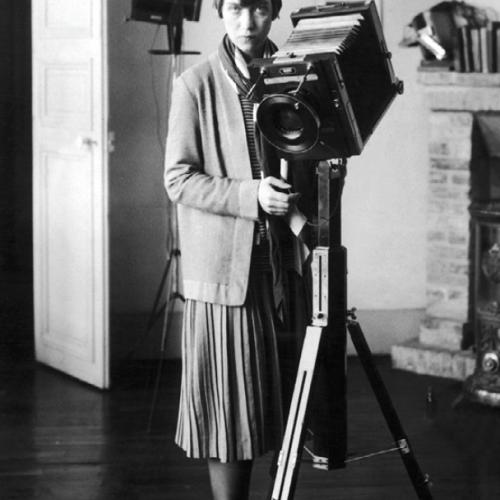
Berenice Abbott in an undated photo, c. 1930s
Photographer and source unknown
Born in 1898 in Springfield, Ohio, Berenice Abbott left Ohio State University after a year to become an artist in New York City. At age 19, she became a Greenwich Village denizen, taking bit parts in Eugene O’Neill plays and teaching Marcel Duchamp the latest dances.
In 1921, Abbott joined the bohemian exodus from New York to Paris, where she pursued her ambitions in sculpture and dance. After two years of travel between Paris and Berlin, she took a steady job as a darkroom assistant to Man Ray, a fellow expatriate with a successful photography practice. In three years time, she had become a skilled photographer and left Man Ray to open her own studio; soon her reputation as a portraitist rivaled his.
Through Man Ray, Abbott met Eugène Atget, an elderly photographer who had spent years documenting Paris. When Atget died in 1927, Abbott salvaged the contents of his studio and made his work her cause. His documentation of Paris inspired hers of New York. Like Atget, Abbott used a cumbersome large-format camera, which enhanced compositional control at the expense of capturing motion.
In her photographs, Abbott often expressed change by juxtaposing the old and the new—skyscrapers looming over tenements or billboards competing for attention with civic monuments. Roughly half of her photographs depict Manhattan below 14th Street, the oldest part of the city, where the contrast was most extreme. Abbott avoided tourist sites, Central Park, and uptown residential neighborhoods. In northern Manhattan and the outer boroughs, she was drawn to clapboard houses and Victorian public buildings, which recalled her Midwestern upbringing.
The Federal Art Project (FAP), a work-relief program for artists under the auspices of the Works Progress Administration, lasted only a few years. Begun in fall 1935, the FAP faced budget cuts in 1937 and deeper cuts in 1939. Although Abbott was an FAP star — her photographs were featured in exhibitions and were the subject of a book—“Changing New York” was ended against her will.
Almost immediately Abbott began thinking about her next “immense subject,” photographing science. Without scientific training and supporting herself by teaching and writing, Abbott labored for two decades inventing ways to visualize scientific phenomena, such as gravity and kinetic energy. In 1958, the Massachusetts Institute of Technology hired her to illustrate an innovative physics textbook and a series of popular books.
In 1961, health reasons forced Abbott to leave New York, and she retired to Maine, where she lived to the age of 93.